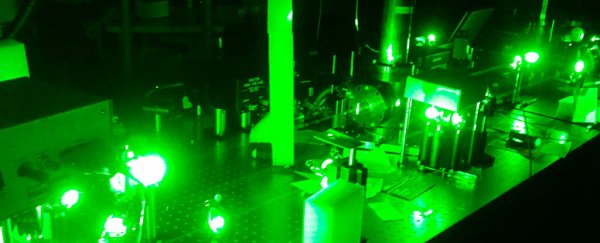Physicists are pretty great at smashing particles such as protons and lead ions together at mind-boggling speeds in particle colliders like the Large Hadron Collider (LHC), but particles are only half the story when it comes to understanding the tiniest interactions that govern the fundamental workings of the Universe.
There are also interactions between particles that behave so consistently, they're almost like entirely new versions of particles - like a single, massive particle, rather than a conglomeration of particles all acting in sync. These phenomena are called quasiparticles, and for the first time ever, physicists have managed to collide some together to see what happens.
If you're still trying to wrap your head around what a quasiparticle is, Michael Byrne over at Motherboard sets the scene, with a hypothetical electron bound to an atomic nucleus inside a metal. when some force comes along and bumps the electron out of its position, this causes the atomic nucleus and the other elections around it to also shift.
"This shift has the neat property of looking an awful lot like one, single really massive electron rather than a collection of particles reacting to the motion of one, single electron with a normal mass," says Byrne.
This collective movement of multiple particles in response to a single stimulus is known as a quasiparticle.
Now that we've got that sorted, why has it taken physicists so long to figure out how to collide these things together, when colliding particles is now the bread and butter of particle physics?
well, unlike solid, defined particles, quasiparticles are fleeting. Just like an elephant is constant (until it dies) while an elephant's interaction with a pretty ribbon stick is only temporary, particular interactions between particles come and go, and physicists have struggled to develop technology that's powerful enough to capture their movements before they disappear.
Because when we say fleeting, we mean fleeting: these interactions only occur for mere femtoseconds - one-quadrillionth, or one-millionth of one-billionth, of a second.
"Since quasiparticles are embedded in a very dense background of billions over billions of interacting particles such accidental collisions happen on very short time scales set by the femtosecond," one of the team, Rupert Huber from the University of Regensburg in Germany, told Byrne. "It is crucial to be fast."
Not only that, but the byproducts of smashing quasiparticles together that physicists need to study only exist for mere attoseconds - one-quintillionth of a second.
Huber and his colleagues figured out a solution to this problem by colliding pairs of quasiparticles called 'holes' together in a material called tungsten diselenide, using a femtosecond laser system, like the one pictured at the top of the story.
As Emily Conover describes at Science News, a hole is formed when a missing electron leaves a void in a sea of electrons. "The hole moves around the material, behaving like a positively charged particle," she says. "Its apparent movement is the result of many jostling electrons."
By tearing the electrons and holes apart and then smashing them into each other inside the tungsten, within 10-millionths of a billionth of a second, the team could record an imprint of the interaction in the light it emits, and then work backwards from there to piece together exactly what happened.
"The collision caused mutual annihilation of the quasiparticles and the emission of a photon, which the authors detected," quantum physicist Dirk van der Marel from the University of Geneva in Switzerland, who wasn't involved in the study, wrote in a commentary in Nature.
"The experiment is therefore similar to studies of electron-positron annihilation in high-energy particle accelerators (positrons are the antiparticles of electrons, which means that they have opposite charge and equal mass to an electron)," he said.
What's really cool is that this experiment has basically set up a quasiparticle accelerator, which many different types of quasiparticles can be tried out on. And while holes are interesting because they appear to behave like positively and negatively charged particles, some quasiparticles don't behave like any particles we've ever seen before.
"The negative and positive quasiparticles in the authors' experiment are similar to electrons and positrons in a vacuum, but a rich variety of unconventional quasiparticles could also be studied, for which no equivalent elementary particles are known," says van der Marel.
While the achievement is great for the advancement of our understanding of particle physics and its place in quantum mechanics, figuring out the inner workings of quasiparticles could also help scientists develop more efficient solar cells and electronics.
So move over, LHC, there's a new (faux) particle accelerator in town.
The results were published in Nature.
